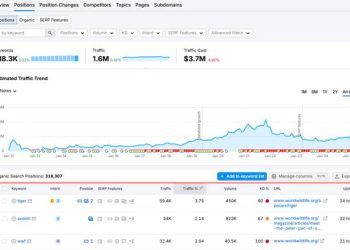What is Bad SEO?
“Bad SEO” refers to unethical, outdated techniques outside of Google’s webmaster guidelines. While SEO aims to make your website more search engine friendly, bad SEO can have the opposite effect.
Bad SEO can lead to poor Google rankings due to missing keywords, weak backlinks and irrelevant content.
Your targeted audience will only see a website with good SEO if it can be seen at all, which defeats the purpose of SEO, which is to be seen.
Duplicate Content:
A strong emphasis on original, high-quality content will be one of the most crucial SEO strategies in 2023.
In most cases, Google will penalise you rather than give you a ranking boost if you succumb to the temptation to repeatedly post the same content or to directly copy the content of others, with or without minor changes.
You must avoid posting duplicate content on your website at all costs if you want to avoid this tactic.
The issue with duplicate content is that it will be flagged by search engines if they already have that content in their index and won’t index the identical page because it offers nothing new.
Additionally, if the same content appears on multiple pages of your website, Google may need clarification as to which page should receive authority.
- Internal Duplicate
Within the domain, this happens. As a result, a page may contain a text block, followed by another page containing the same text block or even identical links.
- External Duplicate
This occurs from other sites if someone has stolen text from you or if you have stolen text from another site.
Keyword Stuffing:
Keywords are crucial to rank. Because it helps google identify the page to rank for the given keyword. Some people do keyword research on their own, or some hire someone who provides services for keyword research.
But, Most People adds this same keyword many times to their blog which looks like artificially pushed keywords just to rank.
It is called keyword stuffing.
Keyword stuffing used to work like crazy and produce amazing results for some businesses. Naturally, it lasted only a short time.
Google modified the search engine’s algorithm once it realised what users were doing. Nowadays, Google can identify keyword stuffing and disallows such websites from appearing in the search results.
Google would ignore your website if you tried stuffing it with keywords. They may even punish you for using unethical SEO techniques.
We continue to observe black hat SEO companies advising their clients to engage in this behaviour.
Due to the number of keywords, this technique previously assisted in ranking higher on search engines.
But now, Google’s crawlers will catch what you did and stop users from seeing low-quality content. Avoid making this SEO blunder at all costs.
Cloaking / Invisible Text:
Using lessons from the past when using proper SEO techniques is one of the worst things you can do.
Cloaking, also known as adding invisible text to a page or showing users and search engines different versions of a page, was one of the most widely used bad SEO techniques in the past.
Businesses would then add a list of keywords hidden from humans but visible to crawlers. They achieved this by making those keywords the same shade as the website’s background.
In this manner, the page would appear “keyword-rich” to search engines without appearing spammy with too many keywords.
Paid links:
SEO’s link-building strategy is crucial, but links must be earned. The same level of care should be taken with backlinks as with the websites they are linking to. When done properly, it can produce excellent outcomes.
When done correctly, it can help the reputation of your website. When an SEO tactician purchases link or uses low-quality links to increase site credit, this is a huge SEO red flag.
Cheap guest posts, subpar domains, and spammy links are all quickly recognised by Google, which will reduce site traffic.
Not using Google Webmaster Tools:
The ranking landscape is complex because Google updates its rankings frequently, and websites typically do the same to rank higher.
The ranking is determined by a large number of factors as well. What tool does Google offer to assess the SEO strength of your website?
Using Google Webmaster Tools is the best way to confirm that your website complies with the requirements.
You’re taking a chance without this kind of resource. SEO experts also use these resources because they gather a wealth of data on keyword research, SERP research, and backlink relevance.
Therefore, think seriously about using this tool if you want to be aware of the situation.
Click Bait:
Similar to cloaking, clickbait is a shock and awe strategy that attracts users with cleverly crafted titles. These “hot-button” titles are full of deceptive lead-ins to increase click-throughs and rankings.
Once more, this might affect your website’s reputation and overall return on investment. Additionally, it’s much more challenging to rank for targeted keywords.
Buying links:
Backlink purchasing and selling was a successful industry. Even though more website owners are becoming aware of the malpractice and putting a stop to it, it is still happening.
One will only take the risk for a short time once Google starts to penalise and flag a website for such practices.
We are not referring to the deals struck secretly to obtain a backlink from a reputable website. This is more along the lines of toxic websites and link farms.
Using Malicious Software:
Hackers and cybercriminals frequently use bugs, Trojan viruses, spyware, adware, bots, rootkits, etc., to take over users’ devices.
They employ the same malware to increase the website’s ranking through unethical and illegal means.
The malicious material is incorporated into gifs, flash, plug-ins, and other web content users attempt to use, play, or download. They also conceal the malware in ads.
Spinning Content:
One of the black hat SEO techniques that many still use is article spinning. Content spinning, typically done by software, entails trying to recreate a text using different sentence structures, words, and phrases.
The result is frequently a jumble of strange synonyms that attempt to mimic the original text but fall woefully short due to a lack of context.
One of the most unethical SEO techniques in the field is taking an article or page that is already ranking highly and trying to create a close spin of the content for your website.
Conclusion:
These days, adhering to moral, good SEO practices based on Google standards and current advancements in ranking algorithms is more crucial than ever for the success of a website.
Using outdated techniques like keyword stuffing, cloaking, massive link building, and banner stuffing is strongly advised.







